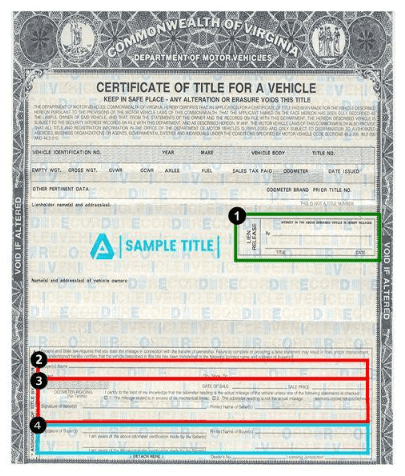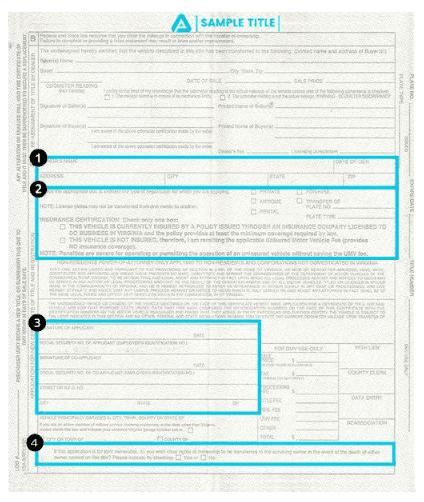How to Transfer a Car Title in Virginia
A title certificate is a legal document that demonstrates ownership of a motor vehicle. When you buy or sell a used vehicle in Virginia, be sure to transfer ownership correctly with a proper title transfer.
A safe and legal title transfer procedure is essential for a successful private vehicle transaction. This guide will teach you everything you need to know about transferring a car title in Virginia.
The Process of Transferring the Title
A car title transfer establishes the buyer as the new owner of a vehicle. A title transfer happens in two stages:
1. The buyer and seller meet up. The buyer pays for the vehicle. Both fill out the physical title certificate and sign it. The buyer is now the legal owner of the purchased car.
2. The buyer registers the newly bought vehicle with the Virginia Department of Motor Vehicles (DMV), and the DMV updates its records to establish the buyer as the titled owner.
The first step (the seller and buyer meeting) is the most important. The second step is a required formality.
1. The buyer and seller meet up. The buyer pays for the vehicle. Both fill out the physical title certificate and sign it. The buyer is now the legal owner of the purchased car.
2. The buyer registers the newly bought vehicle with the Virginia Department of Motor Vehicles (DMV), and the DMV updates its records to establish the buyer as the titled owner.
The first step (the seller and buyer meeting) is the most important. The second step is a required formality.
•
As the seller, you’ll formalize the whole transaction when you transfer ownership of the car by signing the title over to the buyer. You’ll take off the license plates and be done with the car.
•
When the seller transfers the title to you as the buyer in a private car sale, you become the legal owner of the vehicle. You'll finish your title and registration with the Virginia DMV. You'll also acquire new Virginia license plates and car insurance.
Essential Info for Signing a Virginia Title
Always keep the following details in mind when completing the title certificate:
•
Any spelling mistakes make the document illegible.
•
Use only blue or black ink. Any other color will void the title.
•
Never use white-out or delete anything.
•
Write clearly.
•
Use only full, legal names.
Front of Virginia Certificate Title
The front of the title includes sections for the seller (red), lien holders (green), and buyers (teal). Here are the steps for filling out the front of a Virginia title.
1. By entering the necessary information, the lienholder will release the lien (if applicable).
2. In the red rectangle marked “2”, the seller enters the BUYER’S name, address, city, state, and zip code.
3. The seller enters the exact odometer reading, the date, and the sale price, then signs and prints their name in the red field marked “3”.
4. In the teal-colored field, the buyer signs and prints their name.
1. By entering the necessary information, the lienholder will release the lien (if applicable).
2. In the red rectangle marked “2”, the seller enters the BUYER’S name, address, city, state, and zip code.
3. The seller enters the exact odometer reading, the date, and the sale price, then signs and prints their name in the red field marked “3”.
4. In the teal-colored field, the buyer signs and prints their name.
Back of Virginia Certificate Title
There are red and teal sections on the back of the title for the seller and buyer. The following steps will walk you through the process of finishing the back of a Virginia title.
1. The buyer enters the name, address, city, state, and zip code of the lienholder to appear on the new title and the lien date in the teal rectangle (if applicable).
2. The seller verifies the type of registration they are requesting and marks which insurance certificates apply to them.
3. The buyer signs their name and enters the date, social security number, address, city, state, and zip code in the teal-colored space below.
4. The buyer marks yes or no to the question at the bottom of the title (if applicable).
1. The buyer enters the name, address, city, state, and zip code of the lienholder to appear on the new title and the lien date in the teal rectangle (if applicable).
2. The seller verifies the type of registration they are requesting and marks which insurance certificates apply to them.
3. The buyer signs their name and enters the date, social security number, address, city, state, and zip code in the teal-colored space below.
4. The buyer marks yes or no to the question at the bottom of the title (if applicable).
Finalize Ownership Transfer with Virginia DMV
You are officially the owner once you have completed the certificate. But your work is not done. To complete the Virginia car title transfer, you must still take some additional steps. You must also register the vehicle and get new license plates from the Department of Motor Vehicles (DMV) in Virginia. You'll also have to pay sales tax on your new-to-you vehicle.
The following documents must be submitted to your local VA DMV office:
When you file for VA vehicle registration, you will be able to choose what type of license plate you want. Standard license plates cost up to $45.75 in Virginia.
To avoid fines or other penalties, you should register your new car as soon as you get the title.
The following documents must be submitted to your local VA DMV office:
•
Bill of sale.
•
Completed certificate of title.
•
Proof of identity and address.
•
Valid Virginia auto insurance policy.
•
Payment for the title transfer fee: $15.
•
Emissions test and safety inspection.
•
Payment for VA vehicle registration fees: from $30.75 to $116.49.
•
Payment for VA sales and use tax of 5.3% of the purchase price of the car.
When you file for VA vehicle registration, you will be able to choose what type of license plate you want. Standard license plates cost up to $45.75 in Virginia.
To avoid fines or other penalties, you should register your new car as soon as you get the title.
Virginia Vehicle FAQ
Does Virginia require emissions testing?
Some counties and cities in Virginia require that all gasoline and diesel-powered passenger vehicles pass an emissions test.
The following counties and cities require emission testing:
Counties:
- Alexandria
- Fairfax
- Loudoun
- Prince William
Cities:
- Alexandria
- Fairfax
- Falls Church
- Manassas
- Manassas Park
If you live in one of these counties or cities and want to register your car, you will need to find an emissions inspection station and take the test.
The following counties and cities require emission testing:
Counties:
- Alexandria
- Fairfax
- Loudoun
- Prince William
Cities:
- Alexandria
- Fairfax
- Falls Church
- Manassas
- Manassas Park
If you live in one of these counties or cities and want to register your car, you will need to find an emissions inspection station and take the test.




